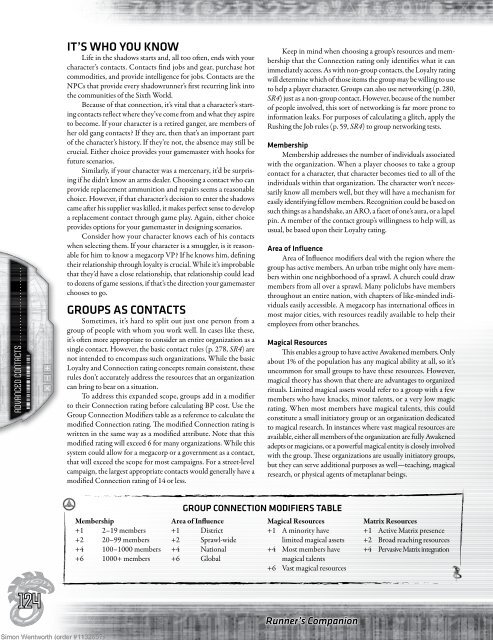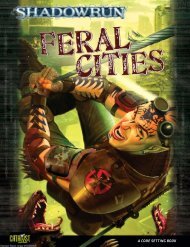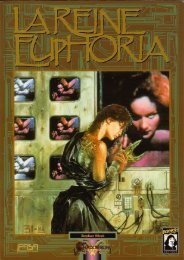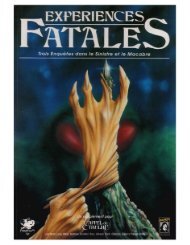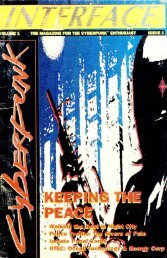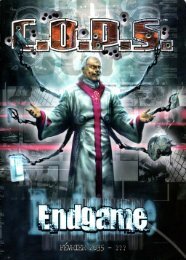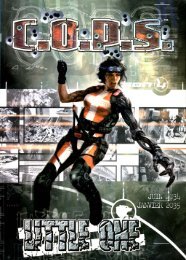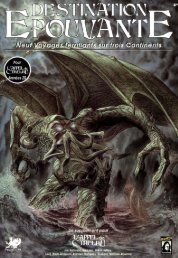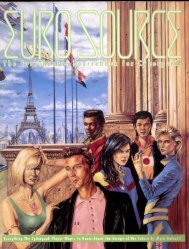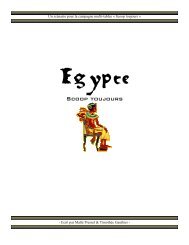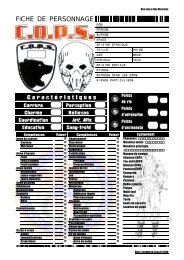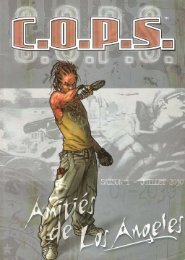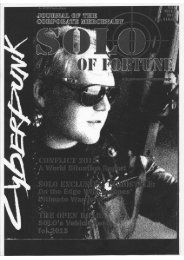Runner's Companion.pdf - Free
Runner's Companion.pdf - Free
Runner's Companion.pdf - Free
- No tags were found...
You also want an ePaper? Increase the reach of your titles
YUMPU automatically turns print PDFs into web optimized ePapers that Google loves.
Simon Wentworth (order #1132857) 9advanced contacts . . . . . . . . . . . . . . . . . . . . . . . . .IT’S Who You KnowLife in the shadows starts and, all too often, ends with yourcharacter’s contacts. Contacts find jobs and gear, purchase hotcommodities, and provide intelligence for jobs. Contacts are theNPCs that provide every shadowrunner’s first recurring link intothe communities of the Sixth World.Because of that connection, it’s vital that a character’s startingcontacts reflect where they’ve come from and what they aspireto become. If your character is a retired ganger, are members ofher old gang contacts? If they are, then that’s an important partof the character’s history. If they’re not, the absence may still becrucial. Either choice provides your gamemaster with hooks forfuture scenarios.Similarly, if your character was a mercenary, it’d be surprisingif he didn’t know an arms dealer. Choosing a contact who canprovide replacement ammunition and repairs seems a reasonablechoice. However, if that character’s decision to enter the shadowscame after his supplier was killed, it makes perfect sense to developa replacement contact through game play. Again, either choiceprovides options for your gamemaster in designing scenarios.Consider how your character knows each of his contactswhen selecting them. If your character is a smuggler, is it reasonablefor him to know a megacorp VP? If he knows him, definingtheir relationship through loyalty is crucial. While it’s improbablethat they’d have a close relationship, that relationship could leadto dozens of game sessions, if that’s the direction your gamemasterchooses to go.Groups as ContactsSometimes, it’s hard to split out just one person from agroup of people with whom you work well. In cases like these,it’s often more appropriate to consider an entire organization as asingle contact. However, the basic contact rules (p. 278, SR4) arenot intended to encompass such organizations. While the basicLoyalty and Connection rating concepts remain consistent, theserules don’t accurately address the resources that an organizationcan bring to bear on a situation.To address this expanded scope, groups add in a modifierto their Connection rating before calculating BP cost. Use theGroup Connection Modifiers table as a reference to calculate themodified Connection rating. The modified Connection rating iswritten in the same way as a modified attribute. Note that thismodified rating will exceed 6 for many organizations. While thissystem could allow for a megacorp or a government as a contact,that will exceed the scope for most campaigns. For a street-levelcampaign, the largest appropriate contacts would generally have amodified Connection rating of 14 or less.Keep in mind when choosing a group’s resources and membershipthat the Connection rating only identifies what it canimmediately access. As with non-group contacts, the Loyalty ratingwill determine which of those items the group may be willing to useto help a player character. Groups can also use networking (p. 280,SR4) just as a non-group contact. However, because of the numberof people involved, this sort of networking is far more prone toinformation leaks. For purposes of calculating a glitch, apply theRushing the Job rules (p. 59, SR4) to group networking tests.MembershipMembership addresses the number of individuals associatedwith the organization. When a player chooses to take a groupcontact for a character, that character becomes tied to all of theindividuals within that organization. The character won’t necessarilyknow all members well, but they will have a mechanism foreasily identifying fellow members. Recognition could be based onsuch things as a handshake, an ARO, a facet of one’s aura, or a lapelpin. A member of the contact group’s willingness to help will, asusual, be based upon their Loyalty rating.Area of InfluenceArea of Influence modifiers deal with the region where thegroup has active members. An urban tribe might only have memberswithin one neighborhood of a sprawl. A church could drawmembers from all over a sprawl. Many policlubs have membersthroughout an entire nation, with chapters of like-minded individualseasily accessible. A megacorp has international offices inmost major cities, with resources readily available to help theiremployees from other branches.Magical ResourcesThis enables a group to have active Awakened members. Onlyabout 1% of the population has any magical ability at all, so it’suncommon for small groups to have these resources. However,magical theory has shown that there are advantages to organizedrituals. Limited magical assets would refer to a group with a fewmembers who have knacks, minor talents, or a very low magicrating. When most members have magical talents, this couldconstitute a small initiatory group or an organization dedicatedto magical research. In instances where vast magical resources areavailable, either all members of the organization are fully Awakenedadepts or magicians, or a powerful magical entity is closely involvedwith the group. These organizations are usually initiatory groups,but they can serve additional purposes as well—teaching, magicalresearch, or physical agents of metaplanar beings.Membership+1 2–19 members+2 20–99 members+4 100–1000 members+6 1000+ membersGroup Connection Modifiers TableArea of Influence+1 District+2 Sprawl-wide+4 National+6 GlobalMagical Resources+1 A minority havelimited magical assets+4 Most members havemagical talents+6 Vast magical resourcesMatrix Resources+1 Active Matrix presence+2 Broad reaching resources+4 Pervasive Matrix integration124Runner’s <strong>Companion</strong>


